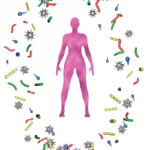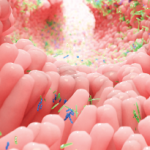Periodontitis & Autoimmunity

Dr. Steere
An epidemiological association exists between periodontitis and RA, and periodontal disease offers lessons on why RA patients may have autoantibody responses to citrullinated proteins, said Dr. Steere.
“In periodontitis, the gingival crevicular fluid becomes inflamed with polymorphonuclear leukocytes (PMNs) and matrix metalloproteinases (MMPs), and this favors certain anaerobic organisms that are able to flourish in an inflammatory environment,” he said. One particularly high-risk pathogen, Aggregatibacter actinomycetemcomitans (Aa), may cause severe periodontitis. Porphyrmonas gingivalis is another risky pathogen associated with gum disease. Research published in 2016 reveals that gingival crevicular fluid (GCF) showed extensive citrullination, mirroring the pattern of hypercitrullination of proteins seen in RA joints.6 Only P. gingivalis has a petidylarginine deiminase (PAD) enzyme that citrullinates arginines at the C-terminal portions of the protein, which may lead to immunoreactive neoepitopes, he said.7
However, the study’s authors “found that RA patients have citrullines in the middle portion of their proteins, as one would expect from citrullination caused by host PADs, not at the C-terminal ends, as with P. gingivalis PADs. They further showed that Aggregatibacter has a leukotoxin, which causes intracellular release of PADs from polymorphonuclear leukocytes. And only Aggregatibacter had the ability to produce a similar repertoire of citrullinated antigens in the GCF as in the RA joint.” It is important to learn whether such processes can play out in the gut, he said.
P. copri & RA
Other bacteria play a role in RA, especially P. copri. A 2013 study found overexpansion of Prevotella bacteria, especially P. copri, in the stool samples of 75% of patients with new-onset RA compared to a significantly smaller percentage of patients with chronic RA or healthy controls.8 P. copri expansion was at the expense of other species, such as Bacteroides, and particularly B. fragilis, which may be important in T-regulatory cell development and function, said Dr. Steere.
A 2016 study conducted in Japan showed that Prevotella, particularly P. copri, dominated one cluster of fecal microbiota from RA patients.9 These researchers then analyzed SKG mice, which have a point mutation in the ZAP-70 gene that leads to defective T cell selection in the thymus. These mice develop Th17-cell-dependent arthritis, but do not develop disease in a germ-free facility. After treatment with zymosan, SKG mice inoculated with Prevotella-dominant feces from RA patients showed increased numbers of Th17 intestinal cells and developed more severe arthritis.
Dr. Steere and his colleagues are studying immune responses to P. copri and novel autoantigens in an effort to link gut microbial immunity with autoimmunity in joints. They developed a discovery-based approach to identify important microbial or self-antigens in RA and in antibiotic-refractory Lyme arthritis based on the identification of HLA-DR-presented peptides from synovial tissue, synovial fluid mononuclear cells (SFMC) or peripheral blood mononuclear cells (PBMC) using nano-tandem mass spectrometry.10 They determined the antigenicity of each peptide by stimulating the matching patient’s PBMC with each peptide in ELISpot assays.
Test results from one female RA patient was of particular interest, he said. She had classic symmetrical polyarthritis and two copies of shared epitope alleles. However, she had a negative result for both rheumatoid factor and anti-CCP antibodies until three years into her disease, when she had first tested positive for anti-CCP.
“She had a good response to DMARD therapy, except for one knee, which remained inflamed,” he said. For this reason, they performed arthroscopic synovectomy of this knee and analyzed her synovial tissue, synovial fluid and peripheral blood for immunogenic HLA-DR-presented peptides, or T cell epitopes. From her synovial tissue, they identified 124 non-redundant HLA-DR-presented peptides from 86 source proteins. Only two peptides were immunoreactive: N-acetylglucosamine-6-sulfatase (GNS) and filamin A (FLNA). “Neither of these proteins were previously described as auto-antigens in RA,” he said. They found 19 non-redundant peptides in her synovial fluid, but none were immunoreactive. From her PBMC, they identified two immunoreactive peptides. One was derived from a P. copri protein, which they called Pc-p27, and the other was a self-peptide derived from FLNA, the same T cell epitope found in her synovial tissue, he said.
In a 2017 study, Dr. Steere and his colleagues looked for T and B cell responses to Pc-p27 in RA patients.11 In patients’ PBMC samples, they found 42% of new-onset RA patients had T cell reactivity with the Pc-p27 peptide. In addition, 32% of patients with new-onset RA or chronic RA had antibody responses to Pc-p27 and/or whole P. copri lysates. One subgroup had IgA antibody responses to P. copri, which correlated with Th17 responses and ACPAs, which suggested a mucosal immune response. The other subgroup had IgG antibodies to P. copri, which were associated with Prevotella DNA in their synovial fluid, P. copri-specific Th1 responses and, less frequently, ACPAs, which suggested a systemic immune response.
They also tested two autoantigens, GNS and FLNA, and found that 52% of RA patients had T cell responses, and 56% had antibody responses to one or both of these antigens.12 “The reactivity with these microbial and self-antigens was significantly more common in patients with shared epitope alleles, as one might expect, since these T cell epitopes were originally identified in a patient with two copies of shared epitope alleles,” said Dr. Steere.
The GNS protein appeared to be citrullinated in vivo, while the FLNA protein did not. GNS antibody levels correlated with ACPA levels, but FLNA antibody levels did not. With both GNS and FLNA, reactivity was seen primarily around the blood vessels in the synovial tissue of RA patients.
“This is common in autoimmune diseases, that reactivity with auto-antigens often occurs around blood vessels. It raises the question of whether this is an early pathological response that is important in what then happens downstream,” he said.
P. copri IgA responses in RA joints, but not P. copri IgG responses, also correlate with two Th1 cytokines in patients’ serum, IFNγ and IL-12, and even more dramatically, with three Th17 cytokines, IL-17, IL-22 and IL-1β, said Dr. Steere.
“These correlations suggest that inflammation may also occur outside the joint, and I’ll postulate that this happens within the bowel mucosa, consistent with the importance of the Th17 response in the pathogenesis of autoimmune disease.”


